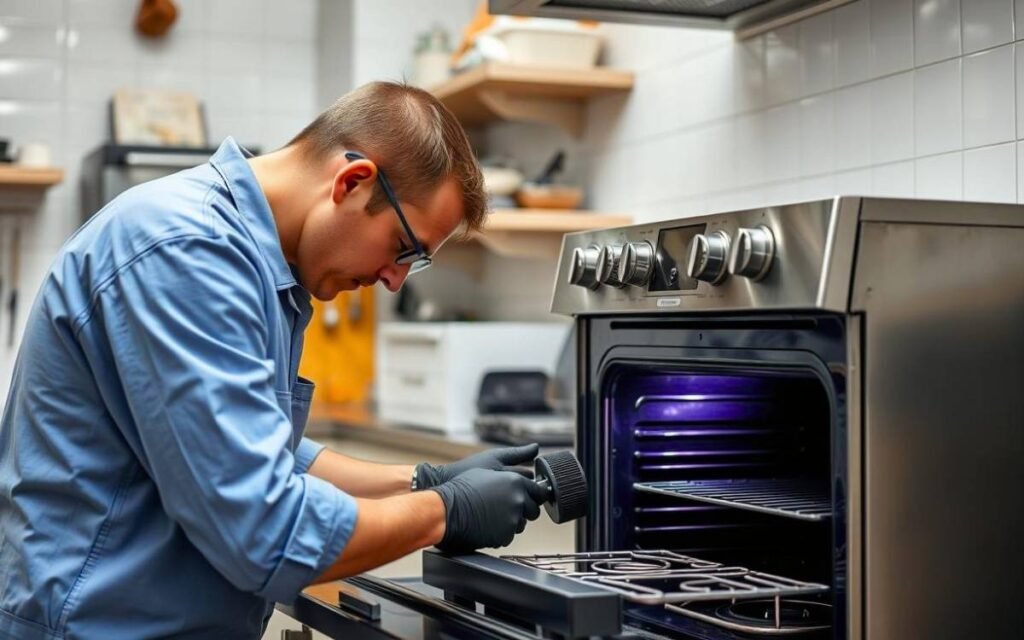There’s nothing more frustrating than having your oven or cooktop give up on you right when you need it. Your Sunday roast is prepped, the pavlova is ready for the oven, and… nothing. A cold oven can throw a real spanner in the works. While your first instinct might be to call for a repair, many common issues can be diagnosed and even fixed with a bit of DIY know-how.
This guide from the experts at Perfect Appliance Repair is designed to walk you through the most common oven and cooktop problems. We’ll help you identify the culprit, give you the steps to fix it, and importantly, tell you when it’s time to put the tools down and call a professional.
Before You Begin Your Inspection
Before you touch a single wire or component, safety is paramount. Do not skip these steps.
- Disconnect the Power: For any electric oven or cooktop, go to your home’s switchboard (fuse box) and turn off the corresponding circuit breaker. Unplug the appliance from the power point if you can access it safely.
- Turn Off the Gas: If you have a gas appliance, find the gas shut-off valve for the appliance (usually located behind it) and turn it to the “Off” position.
- Gather Your Tools: Having the right gear makes the job easier and safer. You will likely need:
- A multimeter (for testing electrical components)
- A set of Phillips and flathead screwdrivers
- A nut driver set
- Pliers
- Protective gloves
Understanding the Heart of Your Oven & Cooktop
To diagnose a problem, you first need to know how the key parts work. Think of this as a quick introduction to your appliance’s anatomy.
- 1.1 The Heating Element (Electric Ovens): Your electric oven has two main heating elements. The bake element is the coil at the bottom responsible for most of the cooking. The broil element is the one at the top used for grilling and browning. If either of these fails, your oven won’t heat correctly.
- 1.2 The Igniter (Gas Ovens): This is the component that lights the gas. There are two main types: a glow bar igniter, which heats up to a bright orange to ignite the gas, and a spark igniter, which creates a spark (you’ll hear it clicking). A faulty igniter is one of the most common reasons a gas oven fails to heat.
- 1.3 The Temperature Sensor & Thermostat: These two work as a team. The temperature sensor, a small rod inside the oven, reads the internal temperature. It sends this information to the thermostat, which then tells the heating element or gas valve to turn on or off to maintain the set temperature. If the sensor is faulty or touching the oven wall, it can send incorrect readings.
- 1.4 The Cooktop Burner Assembly:
- Electric: Usually consists of a removable heating coil that plugs into a burner socket (also called a terminal block). Power is controlled by the infinite switch (the knob you turn).
- Gas: Comprises a burner base, a burner cap (the removable top plate), and ports where the gas flame comes out.
Oven Troubleshooting
Let’s tackle the most common oven issues with a methodical approach.
Symptom: The Oven Fails to Heat Entirely
Potential Causes: Faulty igniter (gas), broken heating element (electric), or a power supply issue.
Step-by-Step Troubleshooting Guide
For an Electric Oven:
Visually inspect both the bake and broil elements. Look for any visible breaks, blisters, or burn spots on the coils.
If an element looks fine, you’ll need to test it for continuity with a multimeter. After ensuring the power is off, disconnect the two wires from the element’s terminals. Set your multimeter to the lowest Ohms setting (Ω). Touch one probe to each terminal. A working element should give a reading between 20-40 Ohms. A reading of infinity (no change) means the heating element has failed and needs to be replaced.
For a Gas Oven:
Turn the oven on to bake and look at the igniter (usually at the back of the oven floor). Does it start to glow bright orange or yellow?
- If it doesn’t glow at all, the igniter is likely faulty.
- If it glows but the gas doesn’t light after about 90 seconds, the igniter is too weak to open the gas valve and needs to be replaced. This is the most common point of failure.
Oven Heats but Temperature is Inaccurate or Food Cooks Unevenly
- Potential Causes: A faulty temperature sensor, incorrect thermostat calibration, or a damaged door gasket.
Step-by-Step Troubleshooting Guide
- Check the Temperature Sensor: Open the oven and locate the sensor—it’s a thin rod, usually a few inches long, near the top back corner. Ensure it is not touching the oven wall, as this will give false readings.
- Test the Sensor’s Resistance: With the power off, disconnect the sensor and test it with your multimeter set to Ohms (Ω). At room temperature, it should typically read around 1,100 Ohms. If the reading is significantly off, the sensor requires replacement.
- Inspect the Door Gasket: Check the rubber or mesh seal around the oven door. If it is torn, brittle, or has gaps, heat is escaping, causing temperature fluctuations. A damaged gasket should be replaced.
- Recalibrate Your Oven: If the sensor and gasket are fine, your oven may simply need recalibrating. Place an oven thermometer in the centre of the oven and set it to 175°C (350°F). After 20 minutes, check the thermometer reading. If it’s off by more than 15 degrees, consult your oven’s manual on how to adjust the thermostat calibration, usually through a sequence of button presses or a small screw on the temperature knob shaft.
The Oven Door Won’t Shut Properly
Potential Causes: Damaged door hinges, broken door springs, or a worn-out door gasket.
Step-by-Step Troubleshooting Guide
- Inspect the Hinges: Open the door partway and see if it feels loose or misaligned. Check for bent or broken hinges.
- Check the Door Seal: A bulky or damaged seal can prevent the door from closing. Make sure it’s clean and sitting properly in its channel.
- Examine the Springs (Advanced): If the door feels floppy, the springs may be broken. This often requires professional assistance as accessing them can be complex.
Cooktop Troubleshooting
Issues with cooktop burners are common and often straightforward to resolve.
Electric Coil Burner Won’t Heat
- Potential Causes: Faulty burner, bad burner socket, or a broken infinite switch.
- Step-by-Step Troubleshooting Guide:
- The Burner Swap Test: Let the cooktop cool completely. Pull the non-working burner straight out of its socket and plug it into another socket that you know works. If the burner heats up, the original socket is the problem. If it still doesn’t work, the burner itself has failed.
- Inspect the Burner Socket: If the socket is the issue, examine it for charring, corrosion, or loose connections. Replacing a burner socket is a common DIY repair.
- Consider the Switch: If both the burner and socket are fine, the issue may be the infinite switch (the knob). Testing and replacing this is more complex and often best left to a professional.
Gas Burner Won’t Light
Potential Causes: Clogged burner ports, misaligned burner cap, faulty spark igniter.
Step-by-Step Troubleshooting Guide
- Listen for the Click: When you turn the knob, do you hear the clicking of the spark igniter? If not, the igniter switch or module may be faulty.
- Clean the Burner Assembly: Food and grease are the biggest culprits here. Remove the grate and the burner cap. Use a stiff brush and a paperclip or a specialized tool to clear out every port where the flame comes out.
- Check the Burner Cap: Ensure the burner cap is dry and seated perfectly level on the burner base. An uneven cap will disrupt gas flow and prevent ignition.
The Gas Flame is Weak or Uneven
Potential Causes: Clogged burner ports.
Step-by-Step Troubleshooting Guide
- Deep Clean the Burner: This issue is almost always caused by blocked burner ports. Follow the cleaning steps above, ensuring every single port is clear of debris for a full, even flame.
When to Put Down the Tools & Call Perfect Appliance Repair
While a bit of DIY can be satisfying, some jobs carry risks that outweigh the reward. Your safety is our top priority. Call our certified technicians immediately if you encounter any of the following:
- You Smell Gas: If you smell gas, do not try to find the leak yourself. Turn off the gas supply immediately, open windows to ventilate, and call for professional help from outside the house.
- Complex Electrical Issues: Problems involving the main control board, internal wiring, or anything that causes the circuit breaker to repeatedly trip require an expert. Faulty wiring is a significant fire hazard.
- The Problem Persists: If you’ve followed our troubleshooting guide and replaced a component but the appliance still isn’t working, there’s likely a deeper issue that requires professional diagnostic tools and experience.
- You’re Not 100% Confident: There’s no shame in calling for help. If you’re unsure at any stage, it’s safer and more cost-effective in the long run to let a trained professional handle the repair.
At Perfect Appliance Repair, our team is fully licensed and trained to handle everything from a simple igniter replacement to complex control board diagnostics for all major brands.
Conclusion
Keeping your oven and cooktop in top working order ensures your kitchen remains the heart of your home. By understanding how these appliances work and following these troubleshooting steps, you can tackle many common issues yourself. Regular cleaning and prompt attention to minor problems are the best ways to prevent costly breakdowns.
However, always remember to prioritise safety and know your limits. When a repair goes beyond a simple part replacement, the expert team at Perfect Appliance Repair is ready to step in and get your kitchen back to perfect working order.
Facing an oven or cooktop issue you can’t solve? Don’t wait.


